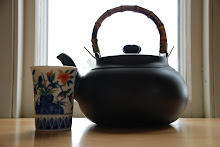 Black currant tea paved the way to my current tea drinking addiction. It was my gateway drug, so to speak. I discovered it during my medicine residency while perusing the aisles of a Whole Foods store. This was in the mid 90s when shopping at Whole Foods was still the progressive thing to do, even in Ann Arbor where I was living at the time.
Black currant tea paved the way to my current tea drinking addiction. It was my gateway drug, so to speak. I discovered it during my medicine residency while perusing the aisles of a Whole Foods store. This was in the mid 90s when shopping at Whole Foods was still the progressive thing to do, even in Ann Arbor where I was living at the time.The loose leaf tea was nicely packaged in a canister bearing the Republic of Tea logo. Up to that point, I had been drinking tea brewed from teabags. Was I ready to make the leap into the adult world of the loose leaf drinking tea set? My slight Anglophilic streak, fostered since my teenage years by the Victorian fatalism of Hardy's tragic heroines and heroes, was tickled pink at the thought of brewing and drinking black currant tea. Dried currants, those tart berries of the genus ribes nigrum, dotted the flaky scones nibbled by English maidens on the windswept heath- those were my associations with currants at that time.
The propensity of flavored teas to overpower the intrinsic nature of the tea leaves themselves with their cloyingly artificial taste has turned me off to them for the most part. However, black currant tea is one of the exceptions. I sipped this self-same tea now, appreciating the alternately tart and sweet flavor of the currants that fortunately did not drown out the taste of the black tea itself. It complemented well the Belgian waffle cookie that I nibbled between sips of the tea. Despite its corporeal firmness, this cookie had a melt in your mouth butteriness that was very pleasing. As I savored my afternoon tea, I was overcome by a desire to open my dog-eared copy of Jude the Obscure.




No comments:
Post a Comment